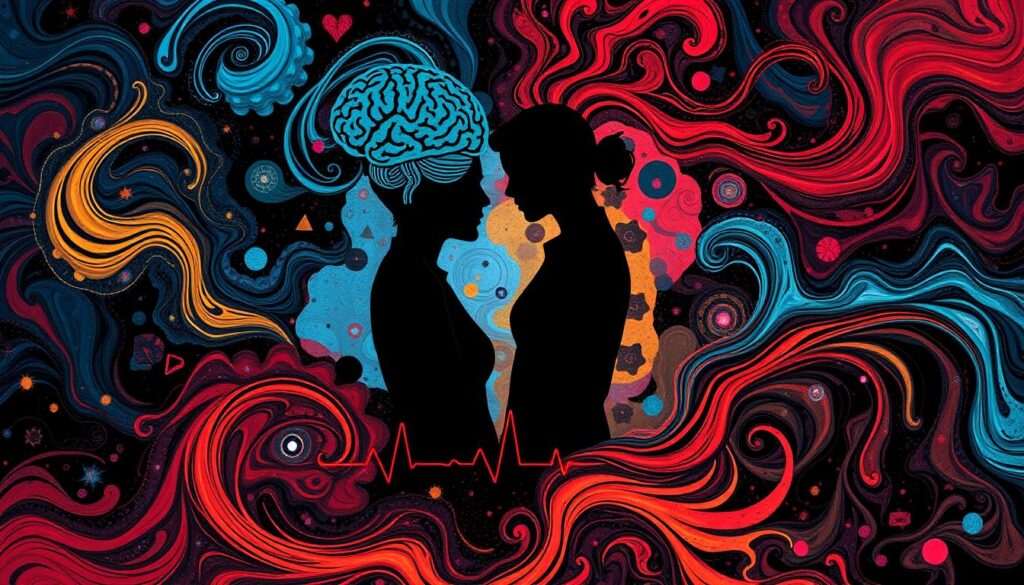The debate on male vs female libido uncovers deep differences in sexual desire. These differences are key to understanding sexual health and relationships. By looking into these differences, we gain insight into why sexual desire varies between men and women.
Introduction to Libido
Exploring sexual desire starts with knowing what is libido. Libido is about an individual’s sexual drive or appetite. It helps us understand human behavior and emotional wellness.

Libido is different for everyone. It’s shaped by many factors. It’s not just about wanting sex, but also how much and why.
Knowing what is libido means seeing it as more than just being turned on. It’s a deep desire for connection. This desire is tied to our emotions and thoughts, affecting our happiness and relationships.
This section aims to explain how libido varies between men and women. We’ll look at what shapes these differences.
Biological Factors Influencing Libido
Libido biology is complex, influenced by hormones and the brain. Knowing these factors helps us understand why men and women have different sexual desires.

Hormonal Differences
Hormones like testosterone and estrogen are key. Testosterone boosts sexual desire in men. Estrogen, more common in women, affects libido but also interacts with other hormones.
Studies show these hormonal differences lead to unique sexual behaviors and desires. For example, a study found here highlights how hormones impact sexual desire in women, showing clear differences between the sexes.
Brain Chemistry
Brain chemistry also plays a role in libido, with neurotransmitters like dopamine and serotonin. These chemicals affect mood, reward, and motivation, all important for sexual function. Both men and women have different levels of these neurotransmitters, adding to the complexity of libido biology.
Understanding how hormones and brain chemistry work helps us meet gender-specific sexual health needs. It also guides us in finding the right treatments for each person.
Psychological Factors Affecting Libido
The mind and sexual desire are closely linked. Many psychological factors shape libido. It’s important to understand how mental health and emotional well-being affect sexual desire for both men and women.
Stress and Anxiety
Stress and anxiety can greatly impact libido. High-stress levels often cause stress-related libido changes. This makes it hard to maintain a healthy sexual desire.
When worries and anxieties fill the mind, the body struggles to respond to sexual stimuli. This can lead to less interest in sex. It also makes relationship challenges more common.

Self-Esteem and Body Image
Self-esteem and body image are closely tied to sexual desire. Negative body perception can cause feelings of inadequacy and lower sexual confidence. This body image affecting sexual desire is a big issue for many.
When someone sees their body negatively, they may feel less sexy. They might also be more hesitant to be intimate. Building a positive self-image and self-esteem is key to a healthy libido.
Societal and Cultural Influences
The relationship between society and libido is complex. Throughout history, culture has shaped how we view sex, often differently for men and women.
Men and women face different expectations about sex. In many places, men’s sex drive is seen as normal, while women’s is seen as changing. This is shown in studies, like one available here, which questions the idea that women’s desire is more variable.
“The study looks at the idea that women’s sexual desire is more variable than men’s because of society and culture. It finds that women’s desire does vary more over time. But, in short periods, there’s no big difference between men and women. Women’s desire is more affected by happiness, closeness with their partner, tiredness, and anger, showing that men’s libido isn’t always stable.”
Culture also plays a big role in how we see sex. In Western societies, there’s more openness about sex. But in more conservative cultures, talking about sex is restricted.
- Culture can either limit or encourage open talk about sex.
- Society and libido together shape how men and women see sex differently.
- Studies question the old idea that women’s sexual desire is more variable.
It’s key to understand how culture affects libido to truly get human sexuality. By changing our views and attitudes, we can have a more open and accurate talk about libido. For more details, check out this study here.
In summary, recognizing the role of society and culture in libido helps us respect and understand individual sexual views. By moving past stereotypes and gaining knowledge, we can change how we talk about sex across genders.
Stages of Life and Changes in Libido
It’s important to know how libido changes at different life stages. These changes are due to hormones, life experiences, and biological factors.
Adolescence
Adolescence is a time of big hormonal changes. These changes make people curious and want to try new things. It’s a key time for figuring out who you are and what you want.
Adulthood
In adulthood, libido can stay steady but is still affected by many things. This includes relationships, stress, and health. Keeping a healthy lifestyle can help keep libido strong.
Menopause and Andropause
Later in life, menopause and andropause can change libido a lot. Women may feel less desire and have vaginal changes. Men may see a drop in testosterone, which can lower libido too. Knowing these changes and getting help can keep sex life healthy.
Male Libido Characteristics
The way male libido works is complex and changes with age. Hormonal shifts play a big role in how much sex men want. Knowing how these factors interact helps us understand male sexual health better.
How Male Libido Varies with Age
As men get older, their libido changes. In their teens and early twenties, testosterone is high, making them more sexually active. But, as they age, testosterone drops, leading to less interest in sex.
Studies show that men’s sex drive often goes down in their 40s and 50s. But, this can vary from person to person. Staying healthy can help slow down some of these age-related changes.
Impact of Testosterone on Male Libido
Testosterone is key in controlling male libido. It affects not just sex drive but also mood and energy. When testosterone is high, men tend to have a stronger sex drive.
On the other hand, low testosterone means less sex drive, less energy, and less motivation for sex. It’s important to keep an eye on these testosterone effects to keep a healthy sex life as we age.
Female Libido Characteristics
The female libido is complex, influenced by many factors. These include both physical and hormonal changes. Knowing how these factors affect female sexual desire is key to understanding female libido.
Menstrual Cycle and Female Libido
The menstrual cycle affects female libido in different ways. During ovulation, many women feel more sexually attracted. This is because of the body’s natural signals for reproduction.
This time, known as the “fertile window,” is when libido peaks. It’s due to the rise in hormones.
Effect of Estrogen on Female Libido
Estrogen is a crucial hormone for women’s libido. High estrogen levels mean more sexual desire. Low estrogen, like in menopause, leads to less desire.
Estrogen balance is vital for women’s sexual health. It shows how hormones impact sexual feelings at different life stages.
How Relationship Dynamics Affect Libido
Relationship dynamics greatly impact sexual desire. Emotional connection, satisfaction, and communication are key. They help keep libido and intimacy in balance.
Couples’ sexual desire can change due to emotional closeness and bedroom dynamics. A strong emotional bond lets partners share their needs and desires freely.
Talking openly about sexual needs and preferences boosts libido and intimacy. Partners who communicate well are more likely to meet each other’s needs. This helps address any differences in sexual desire.
When libidos don’t match, understanding and empathy are crucial. Scheduling intimacy and redefining what sex means can help. For more tips, check out this article on mismatched sex drives.
Common Myths about Male and Female Libido
Many myths surround libido, affecting how we see human sexual desire. By looking into these myths, we can uncover the truth. Here, we’ll explore some of the most common myths debunked by science.
One myth is that men always have a higher libido than women. This idea comes from old beliefs and cultures. But it’s too simple, as research shows many factors affect libido, like hormones and life stages.
Another myth is that libido stays the same throughout life. But it changes due to stress, health, and relationships. Knowing this can help with any worries about sexual desire.
It’s also believed that men and women are complete opposites when it comes to libido. While there are differences, it’s not true to say one gender always has more desire. Both can have high or low libido for many reasons.
Many think libido is only physical. But feelings and emotions also play big roles. Things like anxiety and relationship problems can affect libido, not just gender.
By debunking these myths, we get a clearer view of human sexuality. Recognizing and tackling these misconceptions helps build better relationships.
Health and Lifestyle Factors
Understanding how health affects libido is key for a good sex life. Diet, exercise, and sleep are big factors in libido and health.
Diet and Nutrition
Eating well is crucial for libido. A balanced diet with vitamins and minerals keeps hormone levels right. Foods like zinc, vitamins E and C, and omega-3s boost libido. But, too much processed food, sugar, and unhealthy fats can harm sexual health.
Physical Activity
Exercise and libido are closely tied. Working out boosts energy and mood and keeps the heart healthy. It also improves blood flow to the sexual organs and boosts endurance. So, exercise is key for good sexual health.
Sleep Patterns
Good sleep is linked to libido. Enough rest helps regulate hormones and lowers stress, both good for sex. Bad sleep can make you tired, lower libido, and hurt health. So, getting enough sleep is vital for a healthy sex drive.
Libido Fluctuations: Normal vs. When to Seek Help
It’s important to know the difference between normal changes in libido and when they might be a sign of a bigger issue. Changes in libido can happen due to lifestyle or emotional shifts. But, if these changes keep happening or are really bad, it might be time to look deeper.
Identifying Libido Problems
Spotting libido problems starts with watching for any lasting changes in how much you want sex. A little drop in libido now and then is okay. But, if it keeps going down and you can’t figure out why, it could be a sign of a problem. Stress and anxiety can play a big role in these issues.
Also, changes in your body, like hormonal imbalances, can affect your libido. It’s key to tell the difference between normal ups and downs and when you need help. Keeping a libido journal can help you see patterns and if your feelings are normal.
When to Consult a Professional
If you notice big changes that affect your life, it’s a good idea to talk to a sexual health expert. They can help find out what’s causing your libido issues and create a plan to fix it.
Knowing when to get help with libido is crucial to solving problems early. Talking to a doctor can lead to ways to make you feel better. Remember, asking for help is a step towards better sexual health. Don’t wait if you think something’s off.
Treatment Options for Libido Issues
Libido treatments vary widely, catering to different causes of low sexual desire. One effective approach is therapy for libido, which includes counseling. This helps address emotional and psychological factors. It often solves problems caused by stress, anxiety, or relationship issues.
Medical interventions are also key. Hormone treatments, like testosterone for men and estrogen for women, may be suggested. These treatments aim to balance the body’s natural levels and boost sexual desire.
Medications like sildenafil (Viagra) and flibanserin (Addyi) are also used. They help increase blood flow to sexual organs or affect brain neurotransmitters. This can lead to increased sexual interest and performance.
Lifestyle changes are crucial in treating libido issues. Regular exercise, a balanced diet, and enough sleep are important. Avoiding unhealthy habits like smoking and too much alcohol also helps improve libido.
Alternative therapies, such as acupuncture and herbal supplements, are also promising. While not as scientifically proven as traditional treatments, they can be part of a holistic approach to addressing sexual desire problems.
With many options available, those with libido issues should talk to healthcare professionals. They can help find the best therapy for libido based on individual needs and circumstances.
Male vs Female Libido: Observational Studies and Findings
Extensive libido research has been done to understand sexual desire. These studies give us insight into the gender differences in libido research. They show both unique and shared aspects of male and female libido.
“Sexual desire studies reveal interesting patterns regarding how libido fluctuates between genders, influenced by various biological and psychological factors.”
Researchers have studied sexual desire studies in many groups and ages. They found that hormones and brain chemistry greatly affect libido in both men and women.
The libido research shows why we need to look at gender-specific details when talking about sexual desire. Both men and women see changes in libido, but different factors affect these changes in each gender.
Conclusion
Understanding libido differences is key. It involves looking at biological, psychological, and societal factors. These factors shape our sexual desire in complex ways.
We’ve talked about how hormones and brain chemistry differ between men and women. Life stages also play a role. Knowing these differences helps us understand ourselves and our partners better.
It’s important to accept sexual desire diversity. Recognizing the differences in libido between men and women helps us talk openly about sex. Stress, society, and relationships all affect our sexual desire.
By understanding these factors, we can build stronger, more satisfying relationships. This is based on empathy and knowledge.
Remember, the insights we’ve shared are valuable. They help us see the truth about sexual well-being. By embracing this diversity, we can create more fulfilling sexual connections.






